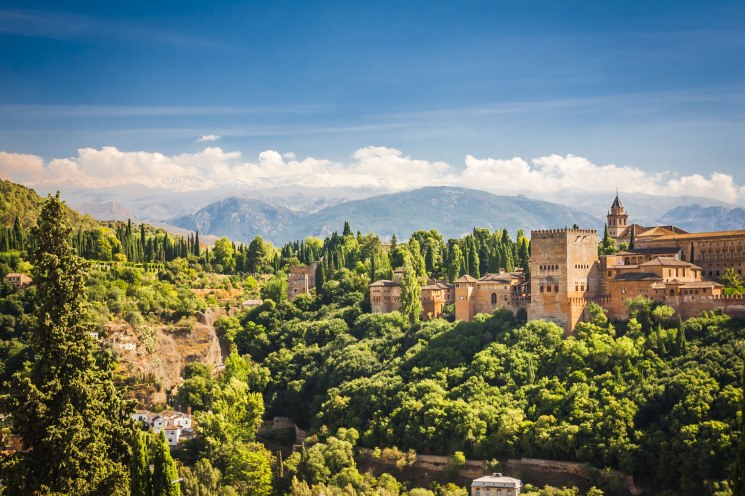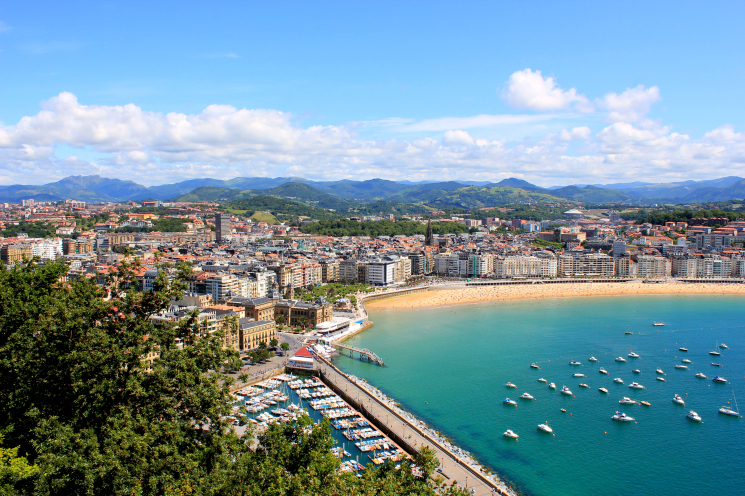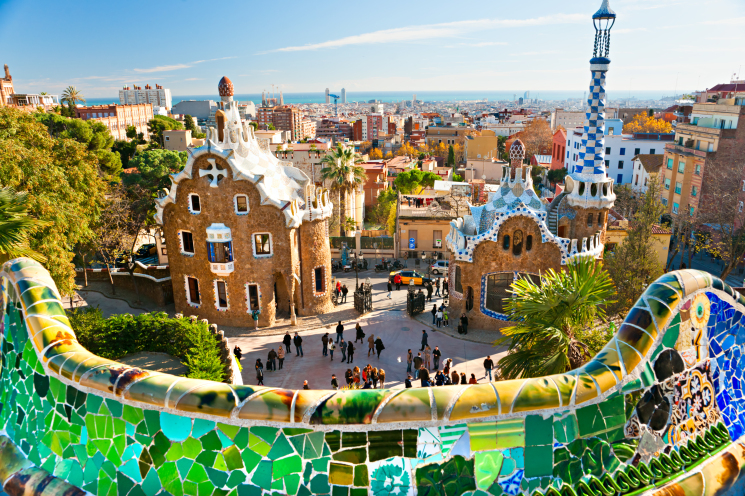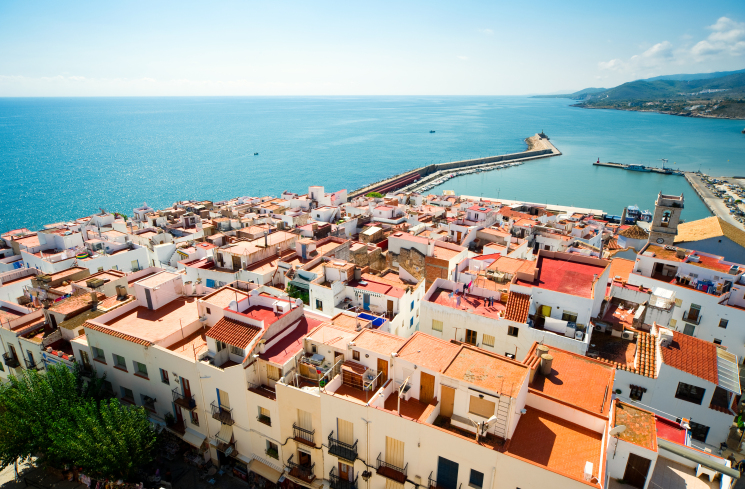If you’re planning a trip to Spain, you’ll quickly discover that buses are one of the most popular and efficient ways to travel around the country. Whether you’re a budget-conscious backpacker or a seasoned traveler looking to explore Spain’s rich cultural heritage, bus travel can offer a comfortable and convenient mode of transportation.
But with so many options available, it can be difficult to know where to start. In this insider’s guide to bus travel in Spain, we’ll share some of our top tips and tricks for getting the most out of your bus travel experience.
We asked travel blogger (and Spain expert) Marie-Eve Vallières to share her insider tips and recommendations. Follow the bus trail on our illustrated map as you read on to discover one of the best ways to travel around the country.

The Ultimate Spain Bus Trip
From short distances to bucolic panoramas, Spain is the perfect country for bus travel. Although Spain is constantly investing in its train routes, there aren’t nearly as many train stations as there are bus stops, and service is infrequent at best, especially when outside major cities like Barcelona and Madrid. In many places, buses are the more accessible, more effective and cheaper way to visit Spain.
As far as itineraries go, traveling from either end of the country to the other is the best way to really get a feel of how diverse Spain is – admire the change in flora and landscapes, from the olive trees and desert in the south, to dense pine forests and chilly Atlantic breeze in the north. España is an incredibly varied country with a distinct set of influences for each province, making any Spain bus trip an incredible experience.
Tip: Visitors prone to transportation sickness should come prepared: Spain is a hilly country, and some of its roads are tortuous and winding. Bring plenty of Dramamine and get to the station early to snap a window seat!

Granada
The perfect Spanish city for budget travel! Granada is a university town and has an energetic, dynamic vibe, with inexpensive accommodation options.
Granada is one culture-charged city, thanks to the presence of Jewish, Moorish and Catholic influences – each shaping the city in its own way. Head to the lively Albayzin neighborhood after nightfall to catch a flamenco show, one of the most Andalusian things to do in Granada. When in Rome, right?
But perhaps the most important Granada insider tip for cash-strapped travelers is that tapas are entirely free of charge – you read that right! Order a drink in any bar (I recommend the two local specialties, the Alhambra beer or the tinto de verano), and you will be served a choice of tapas with every order. ¡Salud!
Top sights: The Alhambra Palace and Generalife Gardens, the historic souk, the Mirador de San Nicolas for a gorgeous view over the city and Alhambra, the remarkable Albayzin Jewish Quarter, and for a taste of the gypsy life, the Sacromonte grottos.
Potential day trip: Sevilla
Insider tip: Granada is one of the top cities in Spain for tasting the legendary Jamón serrano – a cornerstone of Spanish gastronomy. Restaurants and bars proudly hang hams (sometimes as many as 100!) on the ceiling for about six months to let them cure. It’s quite a sight, to say the least!
Bus tip: Make sure to get a window seat to admire the drastic change in landscapes when entering the almost desertic-looking vermillion plains of Andalusia.
Main bus routes to Granada:

Madrid
The Spanish capital never disappoints. Its world-class museums and its lively nightlife will appeal to night owls, and culture seekers alike, or, alternatively, visitors can catch the Real Madrid fever and discover the influence of monarchy on Madrid’s history.
Madrid may be the seat of government and royalty, but it isn’t set in its old ways for such; it’s an innovative, bustling city with a strong creative hub. In fact, rumor has it that Madrid has the largest number of bars per capita of any European city – which would make sense, since Madrileños like to party, often until six or seven in the morning.
Top sights: The illustrious Prado museum, the regal Palacio de Cibeles, la Puerta del Sol, the lively Plaza Mayor, Mercado de San Miguel for local delicacies, Palacio Real, and of course, and the various Real Madrid activities.
Potential day trip: Toledo
Insider tip: You can’t visit Madrid without eating pimientos de Padrón (small green chilies fried in olive oil and sprinkled with sea salt) or finger-licking good chocolate con churros (piping hot churros with hot chocolate).
Bus tip: Madrid, being both the political and geographical center of Spain, is connected to every province in the country and boasts two major bus terminals. So it’s not a bad idea to be based in Madrid and take a bunch of side trips to other parts of the country.
Main bus routes to Madrid:

San Sebastian
Self-dubbed the foodie city of Spain, San Sebastian is a strong contingent in the Spanish tapas game thanks to their unique Basque background. The tapas – most commonly called pinchos by locals – are identified with color-coded toothpicks and offered in self-service; customers pay according to the number of toothpicks on their plate after their meal.
In addition to delicious seafood-based dishes, San Sebastian boasts one of the best in-city beaches in Europe – where else on the continent can you sunbathe, surf and swim literally right next to major historical buildings and churches?
The hike up Monte Igueldo offers splendid views of the city, the ocean and the mountainous countryside.
Top sights: Hiking the Monte Igueldo, the Miramar palace, living the beach life at Playa de Onderreta, surfing & kayaking, and hiking to the statue of Christ.
Potential day trips: Bilbao or Pamplona
Insider tip: San Sebastian is home to impressively designed cathedrals and churches, including the iconic Catedral del Buen Pastor. An architecture-focused walking tour is pretty much mandatory in this city.
Bus tip: If you are traveling to the world-famous bull ride in Pamplona via San Sebastian, make sure to book far in advance – seats sell out real quick!
Main bus routes to San Sebastian:

Barcelona
Barcelona, the Spanish party capital! The massive capital of Catalonia never sleeps, and neither do its visitors – between the world-class attractions to visit in the daytime and the countless tapas bars to experience at night. Needless to say, one does not come to Barcelona to catch up on their beauty sleep.
One of the most popular things to do in the city is obviously to tour the Gaudi buildings, especially since the Sagrada Familia’s interior has been completed. Make sure to take an elevator ride to the top of the spire and admire the dizzying view!
Top sights: Tour the famous Gaudi buildings, the beach, medieval Barri Gotic, the locals-approved tapas bar of Eixample, Plaça de Catalunya, and La Boqueria market.
Potential day trip: Zaragoza
Insider tip: Hop on the cable car up to Montjuïc for unparalleled views of the beaches, the city (including the Sagrada Familia) and, of course, the Mediterranean sea.
Bus tip: If you are traveling to small villages in Costa Brava or even to France, make sure to get a seat on the right-hand side of the bus to get a good ocean view during your ride.
Main bus routes to Barcelona:

Valencia
A trip to Spain should never overlook a stop in the birthplace of paella, the country’s national dish! The capital of the old Valencia Kingdom, and Spain’s third largest city, is home to the world-famous Fallas Festival in March, during which the city is almost literally set on fire (or at least, the paper mâché models created for the festival).
Valencia Cathedral (home to the Holy Grail, the chalice Jesus is believed to have used at the Last Supper) is definitely a must-do, even for non-religious travelers. And despite having some of the world’s best colonial architecture, what really causes visitors’ jaws to drop in Valencia is the otherworldly, uber-modern buildings in the City of Arts and Science (which encompasses several museums and even an aquarium).
Top sights: City of Arts and Science, Barri del Carme, Valencia Cathedral, Silk Exchange, and central market.
Potential day trips: Murcia or Alicante
Insider tip: Be wary of where you choose to eat your paella; being a popular dish, most touristy areas will serve the microwaved kind. Pick a restaurant that either doesn’t advertise its paella or that only serves it at lunch. Locals go to the Saler beach area.
Bus tip: With Valencia being so close to the beach, a seat on the left-hand side of the bus will guarantee unobstructed views of the ocean when coming in from Barcelona.
Main bus routes to Valencia:
Meet Marie-Eve Vallières, our Spain Travel Expert. After having spent years living in Europe as an expat and blogging about it for both A Montrealer Abroad and Eurotrip Tips, she shares her ultimate tips and recommendations on Spain, a country she’s visited countless times. Don’t forget to follow her on Facebook, Twitter, and Instagram for all things travel.
Opening image courtesy of Tourspain
Illustration by: Caroline Lavergne